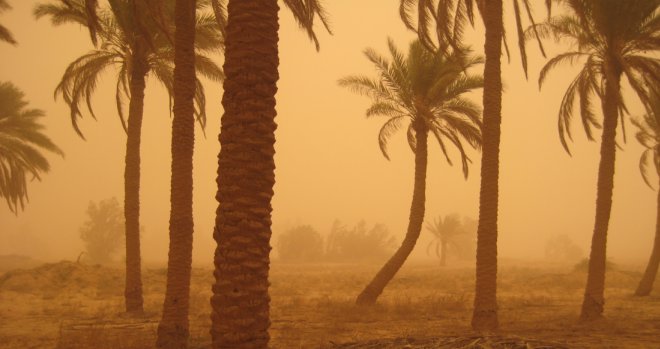Below are the date palms at our oasis. We have been having a little dust lately. This picture was taken at the middle of the day.

Iraq has 12-16 million date palms. This is down from 30 million in the pre-Saddam times but it still makes Iraq the world’s largest producer of dates. In Western Anbar, however, dates are not producing properly this year. Dennis and I did a local check out in the grove in our oasis and could not find even one producing tree. We are trying to figure out how the extent of the problem why it is happening and what Iraqis can do about it. Last year’s crop was good. Even a partial failure of the date crop would be a big problem, so we are very interested is making accurate assessments.
In the longer term, there is a lot Iraqis can do to improve their date production. Some of the techniques they currently use go back to Babylonian times. They are not wrong, but could use some adjustments. Most of these improvements would be easy and organic. For example, planting a cover crop of ladino clover under the trees would help control water absorption and regulate humidity, as well as improve soil. Another management fix is to plant the proper mix of male and female trees. Date palms have gender. Each male tree can pollinate around fifty palms. Pollen is distributed by wind so location makes a difference. It is also useful to plant the male trees on the sunnier part of the grove. Of course there are also the issue of irrigation scheduled to avoid salinity, better genetic quality of palms and modern use of nutrients. Iraqi farmers need to learn some of the new techniques and often relearn some of the more traditional ones.
Dennis also did a field survey of around 10,000 donum (6,000 acres) of irrigated farmland in the Ubaydi area of the Al Qaim district. Things have fallen apart. The tragedy is how easy it would be to remedy the situation IF it could be properly managed. For example, a twenty foot section of a pipe that draws water from the Euphrates is broken. The system could be fixed for a few hundred dollars and an afternoon’s work. Unfortunately the people farming the land don’t own it. The owner is no where to be found. Word is that they have left the country and the uncertainty is freezing developments.
There is also the problem of bureaucratic inertia. In all our districts we find warehouses full of agricultural equipment and fertilizers local farmers need, but bureaucrats representing the authorities are unwilling or unable to release. Some of it related to the problem of who should get it and the land tenure problems I mentioned above complicate every solution. Our ePRT is trying to broken agreements, but our work is made awkward by our incomplete understanding. I am not sure that anybody really knows the answer, but we are looking hard.
There are some things we can and have done on our own initiative. For example, we equipped an agricultural laboratory that will help with things like soil analysis. We are also looking to fund some solar powered water pumps and a we are helping buy some tractor for an equipment rental operation.
In ancient times, Iraq was a phenomenally rich agricultural region. It will be again after we all pass through this rough patch.
